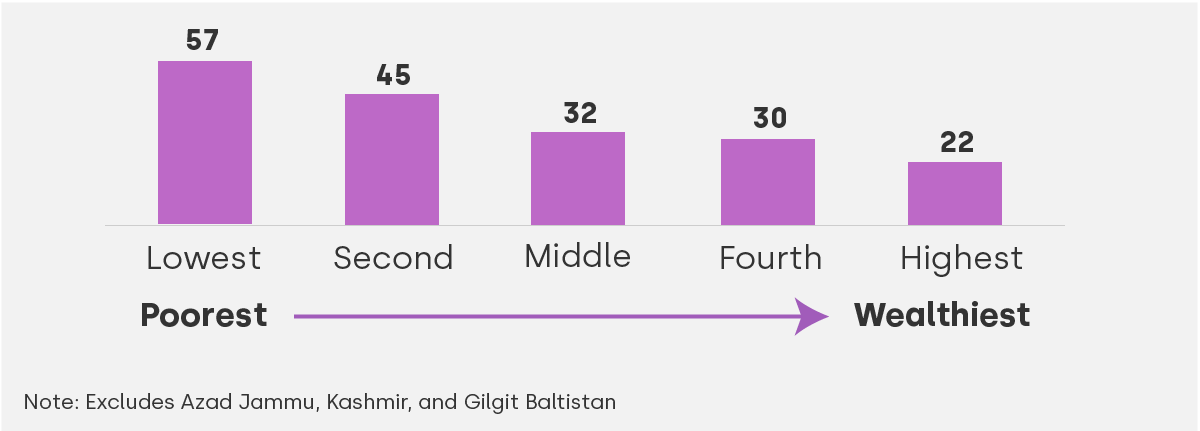
How environmental risk factors affect health and poverty in Pakistan
Environmental risk factors such as air pollution affect health and income disproportionately in lower income households. In this IGC project, we review the long-term effects of non-communicable diseases, malnutrition, and air pollution, particularly on poverty outcomes in Pakistan.
Despite lackluster economic growth in recent years, Pakistan has succeeded in reducing endemic poverty. However, the poor remain vulnerable to economic shocks, with an estimated 52% of the entire population vulnerable to receding into poverty. One of the approaches taken by Government of Pakistan (GoP) to address this vulnerability is the PKR 1.4 trillion Kamyab Pakistan Programme (KPP) launched in October 2021 to support the income growth of small firms and farms through concessional finance and health insurance.
We analysed the sources of vulnerability more broadly, focusing on environmental risk factors affecting health. We reviewed existing data and papers to better understand how Pakistan’s current health burden relates to environmental risk factors, particularly in vulnerable, low-income households.
Non-communicable illnesses drive the most deaths in Pakistan
Data that directly analyses health, poverty, and income linkages is scarce in Pakistan. The Pakistan Household Integrated Economic Survey (HIES) 2018-2019 notes that on average, 3% of monthly consumption expenditures are used for health purposes. Anecdotal evidence suggests that the poor only seek medical help in cases of extreme illness. Research from China, analysing these same linkages, noted that illness is the main cause of poverty in most low-income groups in rural China.
In the last decade, Pakistan has witnessed a significant increase in non-communicable diseases (NCDs), such as ischemic heart disease and stroke. NCDs form 60% of the health burden today and cannot be treated. They need to either be prevented or managed throughout a lifetime, resulting in increasing health costs. A more detailed analysis of Pakistan’s health burden indicates that the two major risk factors that drive the most deaths and disability in Pakistan in 2019 are malnutrition and air pollution (Figure 1).
Figure 1: Risk factors driving death and disability combined in Pakistan

Source: https://www.healthdata.org/pakistan
Malnutrition as a risk factor
Unpacking the malnutrition risk factor is instructive. Poor intake of adequate nutrition, repeated bouts of diarrhoea, and lower respiratory infection among children – particularly, under the age of two years– due to unsafe drinking water, poor sanitation, and poor air quality result in poor absorption of food leading to stunting, which affects future income. Physical stunting is also an indication of mental stunting, thus affecting educational attainment in later years. Moreover, improved nutrition in later years cannot mitigate the cognitive damage, and these children continue to underperform in educational tests. This clearly indicates that stunting cannot be cured, only prevented, and that the lower productivity consequences are lifelong. In extreme cases, this leads to death.
Pneumonia and diarrhoeal diseases are the number one and two causes of children’s deaths (not accounting newborn deaths) in Pakistan respectively. The risk of both these diseases is increased by exposure to environmental risk factors. Furthermore, deaths from pneumonia and diarrhoea are correlated with income quintile in Pakistan. With respect to stunting, Pakistan’s Demographic and Health Survey (DHS) 2017-2018 found that 57% of children under the age of 5 years are physically stunted in the lowest income quintile, and even 22% in the highest income quintile (Figure 2), suggesting that environmental risk factors play an important role.
Figure 2: Percentage stunting in Pakistani children (under 5 years) by household wealth

Source: Pakistan DHS 2017-18
Air pollution as a risk factor
The air pollution risk factor captures both indoor air pollution and outdoor air pollution. It is associated with increased risk of ischemic heart disease, stroke, lung cancer, neonatal morbidity, lower respiratory infections, diabetes, chronic obstructive pulmonary disease, tuberculosis, and blindness. There is little research in Pakistan, but evidence from other countries suggests that air pollution causes death and disability, as well as reduced labour productivity and reduced human capital outcomes later in life, including reduced performance in academic and cognitive tests, depressed earnings, and higher incarceration rates.
Air quality in several Pakistani cities has deteriorated considerably over the years. Pakistan ranked third in a list of the most polluted countries in 2021. According to Pakistan’s Social and Living Standards Measurement Survey (PSLM) 2019-2020, only 37% of households have access to clean fuel technology for cooking and lighting. The poor rely on cheap fuel such as biomass and coal to meet their energy demands. These solid fuels release very high levels of toxic pollutants inside the household, disproportionately affecting women and children.
Policy implications
This suggests that there could be significant gains associated with tackling environmental risk factors that affect health, in particular air pollution. This could be approached through improved coordination across existing programmes that strive to improve air and water quality, with loan programmes (such as KPP), since at a geographical level, this could yield better health and productivity outcomes on the ground.
There is also considerable overlap between interventions to improve air pollution and reduce greenhouse gas emissions. Hence, a compelling way for Pakistan to approach its climate action plan could be through GHG-reduction interventions that also yield considerable local and national benefits, such as improved health for all Pakistanis, increased productivity, and reduced vulnerability of low-income households.

